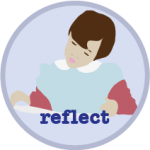Reflect
Part of these packages: Explore and create
Supported by these technologies: Blogger,
Students and the teacher record, post and share audio-visual reflections and feedback of project progress, challenges and future steps. The students slowly build a shared collection of ways to tackle challenges, which can be used after the project ended. Classroom time: Approximately 10 minutes
1. Prepare / Listen
- Develop your competence and expertise, by exploring how often and by whom reflection and feedback could be used in the learning story and by decide on the reflection tool that you would like to set up and use.
- Before recording another feedback or reflection listen to the previous one.
2. Inspire
- Motivate the students to reflect on their work by expressing the benefits and reasons for reflection, for example easier review of the last steps, catching up after an absence, receiving direct feedback from the teacher.
- Tell your students that in design related learning projects, regular reflection can support letting go of initial, not very good, ideas and to develop the feeling of ownership.
3. Coach / Question / Support
- Teams reflect on what they did, what they plan to do and the challenges they encountered or can foresee.
- The first reflections may be difficult to record smoothly. Coach students to overcome initial feelings of frustration or inconvenience. Be assured, after recording a few reflections, you will start to recognize the value of your investment.
- Teams listen to the recordings by others and record questions and tips for them. Coach and support them in doing so.
- Listen to the recordings and adopt your teaching to the needs of the students.
- Record audio-visual feedback for the teams, including questions and suggestions that may inspire the teams to think further, based on the student reflections.
- Experts may be invited to record feedback to the student teams. Their feedback is may become ubiquitous, and a source of inspiration for the students in the years to come.
4. Assess
- You may assess based on the student’s ability to listen and react to your constructive comments, or based on the depth or relevance of their reflections.
Additional ideas for assessing partially completed projects:
- Review all work. Compare everyone’s progress updates with their presentations to see if all important steps are included in the presentation.
- Review all reflection recordings and discuss the process with the students. What was their experience like? What have they learned? What would they like to explore further?
- Student work can be used for open feedback and reflection sessions.
- You could assess the documentations for their value as resources for exam preparation.
This post is also available in: Spanish Hungarian Turkish











